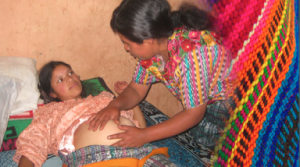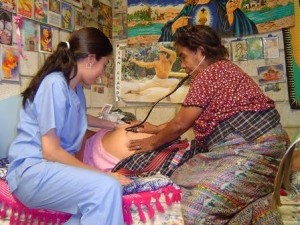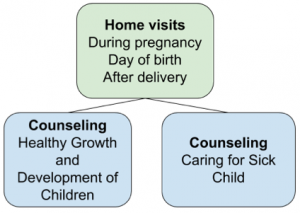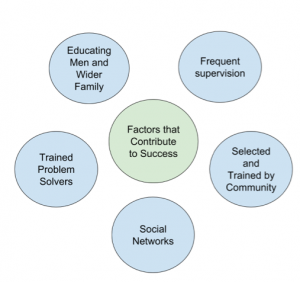The Role of Midwives –“Parteras”
“My inspiration to study nursing is my mother. She has always helped our community as a health leader and midwife. I was inspired of what she was capable of doing without ever having received a formal education, but was still able to have a profound impact on my community.” Mariela Martinez, a nursing school graduate […][1]
Midwives have been an important part of Nicaraguan culture, society and health care for centuries. A midwife is a birthing assistant who stays with a mother during her pregnancy, delivery, and after birth, giving her pre-natal care and support. A midwife is there not only for immediate pre and post-natal care, but also for social, psychological, and spiritual needs of a mother and her family. Most common in rural areas today, midwives are well known and trusted members of a community who respect local traditions concerning the birth of a child. There are no official systematic approaches to midwifery. Midwives take a person-specific approach and guide women in decisions related to their pregnancies. Since the midwives are members of the community as well, they often share the same local theories and explanations for disease causation and prevention, and are often viewed as partners rather than providers. This highly personal relationship gives midwives access to personal information that is helpful in assisting a mother’s help[2].
Image of a midwife examining a pregnant mother.
Like most traditional birth assistants, midwives are trained through an apprenticeship, where an experienced midwife will train a young woman for many years, passing on her skills. The process is long, and it takes years and even decades until an apprentice assumes an official role and begins solo practice. By the time an apprentice becomes a midwife, she has been established in the community and is well known and accepted, ready to fulfill her socially as well as medically.[3]
One challenge that the midwife practice faces is incorporating new biomedical ideas and methods into practice. Most midwives come from populations with low rates of literacy, economic resources, and access to primary care. The lack of up-to-date training and knowledge can have a detrimental impact on reproductive health outcomes. To combat this, many international health organizations during the 1970s and 1980s launched formal training efforts across Latin America to teach midwives how to use basic biomedical technology. This gave them greater agency in the primary health care system and enabling them to serve as a link between their communities and higher health organizations. [4]
Today, many midwives and health practitioners work together with mothers during their pregnancies. Both parties work together to bring the best possible outcome for the mother and baby’s health. Often times, a mother will bring in her midwife to a clinic with her, both for psychological support and personal perspective.
Midwife and community health worker working together
Community Health Workers
Community health workers are the bridge between community health and the health facility.
There is ample evidence from research and implementation to show that community health workers (CHWs), when appropriately trained, supplied, supported and supervised, can identify and correctly treat most children for pneumonia, diarrhoea and malaria [1,2]. Community management of childhood illness is an important contribution to the remarkable progress in reducing child mortality.
The CHW counsels families on practices that they can carry out at home, concerning infant feeding; communication and play for child development; recognition of and response to childhood illness; and illness prevention (handwashing, vaccination, use of bednets).
The treatment interventions include the use of four simple medicines: an antibiotic, an antimalarial, oral rehydration salts (ORS) and zinc tablets.
There are many factors that contribute to success, including those in the diagram above. All of those factors combined lead to the most success for community health workers.
Sources:
[1] https://www.bridgestocommunity.org/community/siuna
[2] https://books.google.com/books?id=914qxUImfMkC&pg=PA11&lpg=PA11&dq=comadronas+in+latin+america&source=bl&ots=–jcD7ZTFd&sig=2RBUdb1H45O8hRdKXuYGTCpGHXA&hl=en&sa=X&ved=0CB4Q6AEwAGoVChMIlKOW4s6ByQIVDHQ-Ch1lrAcD#v=onepage&q=comadronas%20in%20latin%20america&f=false
[3] https://books.google.com/books?id=914qxUImfMkC&pg=PA11&lpg=PA11&dq=comadronas+in+latin+america&source=bl&ots=–jcD7ZTFd&sig=2RBUdb1H45O8hRdKXuYGTCpGHXA&hl=en&sa=X&ved=0CB4Q6AEwAGoVChMIlKOW4s6ByQIVDHQ-Ch1lrAcD#v=onepage&q=comadronas%20in%20latin%20america&f=false
[4] https://books.google.com/books?id=914qxUImfMkC&pg=PA11&lpg=PA11&dq=comadronas+in+latin+america&source=bl&ots=–jcD7ZTFd&sig=2RBUdb1H45O8hRdKXuYGTCpGHXA&hl=en&sa=X&ved=0CB4Q6AEwAGoVChMIlKOW4s6ByQIVDHQ-Ch1lrAcD#v=onepage&q=comadronas%20in%20latin%20america&f=false
http://www.globalhealthaction.net/index.php/gha/article/view/23968





Excelent article i will upload to my website https://hans.ro/
All the best
Mark